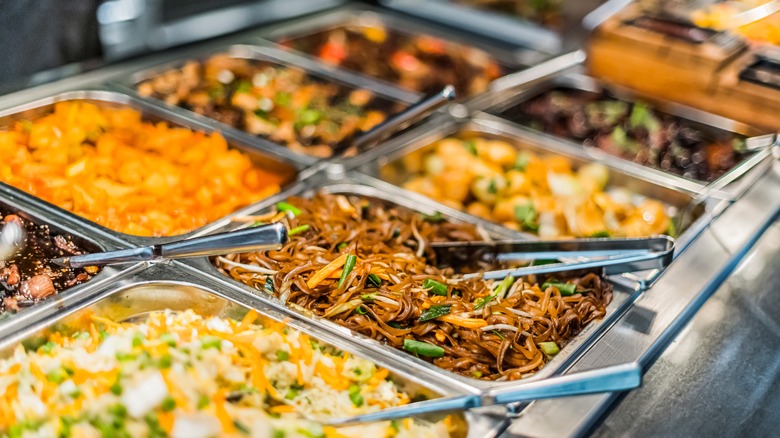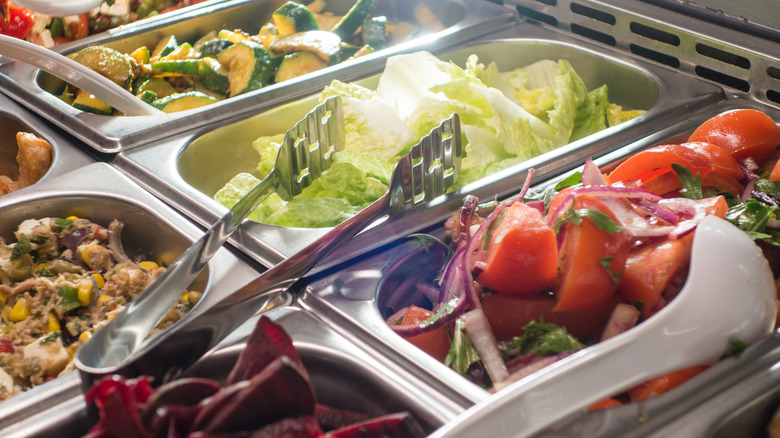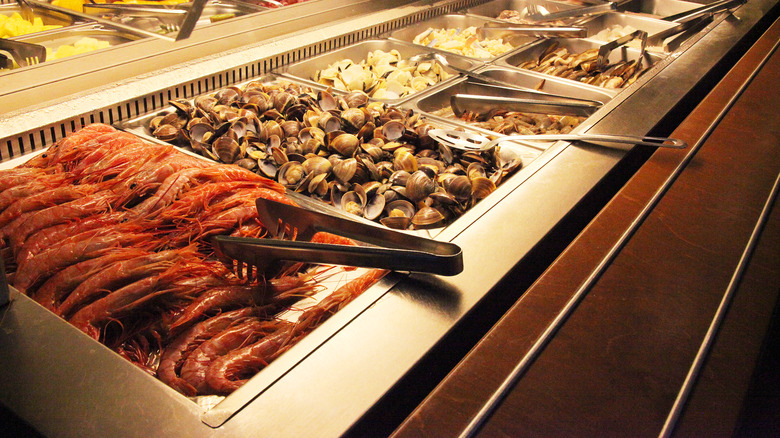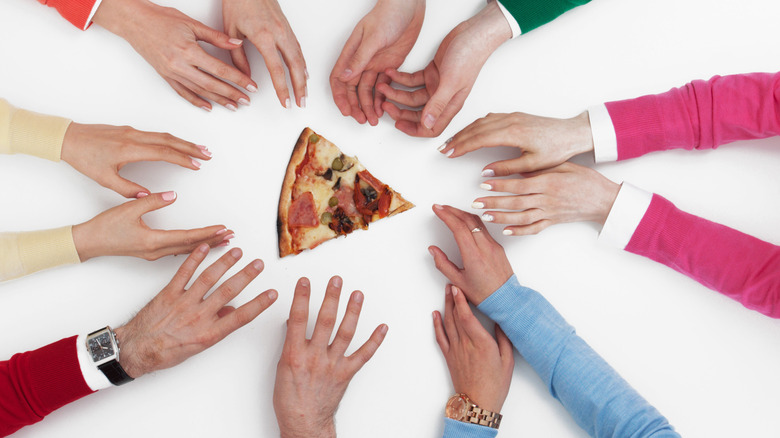11 Mistakes You Might Be Making At All-You-Can-Eat Buffets
There are many mistakes you could make at the best buffet in your area, but the worst is missing out on the experience. All-you-can-eat buffets are fun — you get to try as many dishes as you want — and even the picky eaters in your family will find something to munch on. It's not a problem if you don't like the mac and cheese — leave it, and head back to the counter for some pizza. Conversely, if the twice-baked potatoes are particularly delicious, you can serve yourself as many as you want. Then, you can try all the available desserts — brownies, cookies, ice cream, and pie. That's satisfaction!
The all-you-can-eat experience doesn't work for everyone though. Some diners find themselves falling into psychological warfare with managers or entering unbridled competition with other customers. Perhaps, the food doesn't taste particularly delicious or you feel exhausted by the busy environment and overwhelmed by the choice. It sounds like your buffet experience has been tainted by a few simple mistakes. That's good news because altering a behavior or two will transform your experience. We've got the lowdown on common mistakes you might be making at the all-you-can-eat buffets and how to avoid them.
Not planning ahead
Think before you act — that's a rule for life, but it applies to all-you-can-eat buffets, as well. Buffets feel like a situation where winging it is acceptable. That's true — nothing terrible will happen. Worst-case scenario: you fill up on cheesy mashed potatoes and regret not seeing the ribs earlier. On the other hand, having a game plan will ensure you eat exactly what you want.
Buffet managers often lay food out in a way that encourages people to serve larger portions of cheap, starchy dishes like roasted potatoes. Then, they put expensive beef or seafood entrees in hidden areas, more sparsely, and with smaller serving utensils. The tactic is successful and diners put smaller portions of these foods on plates. If you've thought ahead about grabbing some shrimp, you won't be fooled by sneaky strategies, nor will you be led astray by cheaper starches.
Next, before grabbing a plate, walk along each counter to see what's available. Consider every option and locate the foods you thought about before coming. Now, you can decide on the two or three you want most — it could be fried chicken and cheese ravioli. Start with those, and remember you can always go back and try some sausage pizza later if that was your runner-up.
Everyone benefits from planning, but it's essential for special diets, for example, low sugar or cholesterol. Buffets encourage overindulgence if not planned properly and thinking ahead means people can eat a treat without going overboard.
Going there to relax after a long and tiring day
It's a familiar scenario for many of us: You're home from work after a stressful day and you just don't feel up to making dinner — not even a microwave burrito. So, you corral your family into the car and head to the all-you-can-eat buffet just down the road. Once you get inside, you don't feel any better, though — the choices are overwhelming and the huge dining room is packed with people and noise. You grab several pieces of pizza without even looking at the offerings, sit at your table, and start eating yourself into a food daze.
You may be feeling decision fatigue. Brain power fuels every choice, starting with what clothes to put on first thing in the morning to what's for lunch. Brains get sluggish after long days with hard decisions. Heading to a buffet if you're feeling like this is counter-productive — you're forcing more choices on yourself. Having options is fun, but only when you're rested enough to make the most of it.
There's another reason to skip the buffet if you're feeling tired: you'll likely consume more than you would otherwise. Research conducted by Uppsala University showed that people served themselves larger portions of energy-dense foods when they were sleep deprived. Study participants who'd slept for eight hours the night before chose more reasonable snack sizes. That's a good reason to head to the buffet for Sunday brunch after a long restful night of sleep.
Eating too much
Your visit to a buffet could end in discomfort if you eat too much. Feeling stuffed is not pleasant. Your stomach has to expand to make room for the excess food and pushes against other organs. Sluggishness, drowsiness, and even dizziness occur sometimes after overindulging, and it also makes heartburn more likely.
Unfortunately, buffet settings encourage people to overdo it. For some people, it's like a challenge — they want to get their money's worth. Economists Brian Wansink and David R. Just found that the higher the cover fee charged in a buffet, the more customers want to eat — the way the food tasted had no impact on the amount people consumed. Thinking about the price in terms of the variety offered or how much fun your group has at a restaurant are positive ways to reframe it so you don't feel the compulsion to overeat.
If you eat more than you need once or twice at a buffet, it will result in immediate discomfort, but won't have any long-term consequences. On the other hand, if it becomes routine, you could put yourself at risk for a range of health problems. For example, a survey conducted by Washington University in Saint Louis revealed that people who reported frequent buffet visits, and few opportunities to exercise were more likely to suffer from obesity.
Not paying attention to your plate
You'll notice people at buffets arranging the strangest combinations on one plate — for example, lasagna, beet salad, and brownies. Coming up with interesting food pairings is invigorating, but that's not what's going on. People at all-you-can-eat restaurants often pile everything onto one plate, willy-nilly, to avoid making multiple trips to the counter. They're committing a rookie error and there is value in eating more mindfully.
What your food looks like and how it's arranged on a plate is important — it can enhance or detract from your sensory experience. To be more mindful, first, consider which type of plate you want to use. Large plates encourage people to serve generous portions while small plates have the opposite effect. Think carefully about the size you prefer. There could be bowls available and some people use these for pasta, rice, and stir-fries to keep them warm for longer. Check that the vessel you choose will optimally fulfill its duty.
Next, select two or three foods that go together and artfully arrange them. When you finish the first course, go back to the buffet and pick another set. Eat dishes in an order that makes sense to you. That could mean starting with a salad, moving on to an entree, and finishing with dessert. Other diners might make a slice of pie their first pick and end with salad. Whatever you serve yourself and however you place it on your plate, do it intentionally rather than haphazardly.
Serving yourself huge portions
The scoop is in your hand and you know how to use it. At a buffet, you can serve yourself as much ice cream as you want — there is no one to stop you. Yet, limiting the amount you choose is to your benefit.
First, if you eat a big portion of one food, like General Tso's chicken, you won't have much room left for other delicacies, like crab rangoon or fried tofu. Most of the fun of going to a buffet is getting to nibble on this, grab a bit of that, and try a spoonful of something else. Big servings will reduce the variety of your experience.
Even worse, you'll likely enjoy your large portion of cheesy broccoli casserole less than a smaller one due to sensory-specific satiety. The psychological terminology sounds complex, but the meaning is simple: the first bite of food is the most delicious — always. The first taste awakens your senses. Every subsequent bit provides less and less pleasure as you eat it. For example, the first sip of Coke is mind-blowingly sweet, but if you drink a big glass of cola, it loses its flavor and impact by the last swig. Use this information to your favor: serve yourself everything you can, but just a tiny bit.
Getting wild with serving utensils
You want drumsticks and scalloped potatoes. There's a problem, though — there's no serving spoon in the bin of scalloped potatoes. That's easily solved, so you reach over for the mashed potato spoon and use it as a substitute. Believe it or not, you've just broken a rule and put other diners' health and safety at risk.
Washington State University's rules for buffet etiquette say not to use serving utensils in other bins, grab the wrong end of them, or remove them from the bin. Always use serving spoons or tongs and never grab food with your hand, even if it is just a bread roll. Touching utensils inappropriately is a sure way to spread germs. Moving spoons to different bins can spread allergens from one food to another. Consider the example with the scalloped and mashed potatoes. Recipes for scalloped potatoes often call for a spoonful of flour while there's no wheat in mashed potatoes. By mixing and matching the spoons you could put someone with Celiac disease at risk.
There's an even worse problem. When researcher Robert Sommer observed 379 people at a range of restaurants, he noted 45 incidents of finger-licking at buffet counters — most often at the salad dressing station. That means that approximately one out of every ten people did this. Please, don't lick your fingers while you're serving yourself — it contaminates food for other diners.
Selecting foods that lose their freshness quickly
According to the Food and Drug Administration, perishables shouldn't sit on a buffet for longer than two hours, unless chilled or heated. Most dishes there are relatively fresh, then, but consider what that period means for items like fries and chicken breast. Fries are crispy for about 10 minutes after cooking. Afterward, they're soggy and sad. Chicken breast gets tough and chewy in mere minutes off the grill.
Diners can't know how long bins have sat out at a buffet unless they watch incessantly. Then, they could serve themselves only the freshest foods as waiters place out new bins. That takes concentration, though, and you're there to have fun. A better solution is skipping breast and fries and choosing foods that become more delicious over time. For example, the flavor doesn't immediately permeate through rice dishes, like arroz con pollo. It's best to eat this about twenty minutes after it comes off the burner and no earlier. Other dishes that fare well over longer periods are soups, stews, casseroles, lasagna, and baked pasta. Finally, some buffets have the perfect solution to this very problem — special stands to make omelets, crepes, and other quick foods on demand.
Worrying about the freshness of buffet food is a health concern, and some foods present a higher risk of poisoning than others. The Canadian Institute of Food Safety says to be particularly aware of meat, fish, shellfish, eggs, dairy, and leafy greens.
Eating from your plate while standing at the buffet counter
"What harm does a little nibble do?" you think as you pop a grape into your mouth. You're waiting at the omelet stand and there's a long line in front of you. You're not alone, eating in line at buffets is a frequent occurrence — Robert Sommer's research found that one out of every nine customers ate food from their plate while waiting in line. It's still a mistake, though.
It's imperceptible to the naked eye, but as you eat, you spray a mist of saliva from your mouth. This floats through the air and can land on the food at the buffet table. No one wants to eat food with your spit all over it and you don't want their drool on yours. Everyone will be happier if they simply wait to get back to the table before digging in.
Going back to the buffet with a dirty plate is a related problem. You may think you're doing the staff a favor or saving water by soiling fewer dishes. Think again. When you go back to the counter with a dirty plate, you could contaminate the serving utensils with the bits of food that are left there. Buffets have a good reason to ask customers to always use a new plate — it's one of many important food safety rules that you need to know.
Getting into the famine mindset
You've been waiting for this moment since you walked into the Buffet at Wynn — the server has arrived with a bin of steaming crab legs. You'd heard of the opulence of Las Vegas' all-you-can-eat restaurants, but now you're seeing it. Those crab legs were why you paid $70, but now other diners are edging out of their chairs and eyeing the competition nervously. Who will get there first and who will get the most?
Buffets, even the nicest ones, unwittingly play with people's famine mindset. It's natural — customers want to get the most for their money, but managers don't set out too much of expensive dishes. Despite the abundance around them, people feel like there won't be enough of the most coveted foods, and the competition begins. In one extreme instance, a woman, her teenage son, and another diner brawled over crab legs in a Connecticut buffet.
Think about it, though — you went out to eat because you wanted to have a nice time, especially if you're in Las Vegas on vacation. A scarcity mindset is the opposite: you don't feel happy, content, or fulfilled. Before walking into an all-you-can-eat buffet, ask yourself how disappointed you'll feel if you don't get your metaphorical crab legs. If your answer is, "Very," consider heading to a different restaurant where you can order what you want, with no competition. For example, seven medium crab legs at Joe's Seafood, Las Vegas, cost around $70 and you won't have to fight for them.
Letting your littles serve themselves
He tugs on his mother's pant leg. He wants her to pick him up so he can see everything on the buffet because he's too short. She's taking too long, though, so he decides to scramble up onto the counter. It's a fiasco.
Most people have seen something like this mother and son duo at a buffet. In fact, Robert Sommer's research studying restaurant health and safety recounted this very situation. Not only that, but they found that many health and safety issues were more likely to arise when children served themselves at buffets. Spillage, grabbing with hands, tasting, mixing of serving spoons, and heads under sneeze shields were all far more frequent with littles.
This is not to say that families shouldn't go to all-you-can-eat restaurants. Buffets are popular with kids since they can choose exactly what they like. The atmosphere is more relaxed so extra noise and movement go largely unnoticed. However, there are some steps parents can take to make sure other diners don't have to worry about contaminated food. For example, agree on a course of action with your family beforehand. That could mean mom will put food on the plate for kids, or mom will walk beside littles as they serve themselves to intervene if there's a problem. If kids are old enough to serve themselves, review safety rules with them so they know what behaviors to avoid.
Forgetting the tip
Forgetting to leave a tip on the table as you head out of an all-you-can-eat buffet is a mistake. It may seem unnecessary since waiters have less to do at these kinds of restaurants — they only have to clear tables, refill drinks, and keep an eye out for any health and safety issues. The customers serve themselves after all, so a service tip might appear unfair or over the top. This is not the case — it's important to value the work of servers by leaving a tip, even at an all-you-can-eat joint.
The Bureau of Labor Statistics says that waiters in the US earn a median hourly wage of $12.50 per hour which comes out to $26,000 per year. That's not much compared to many other professions. They have to work hard, spending a lot of time on their feet and sometimes carrying heavy bins to the buffet counter. They can also have difficult face-to-face interactions with customers which can lead to emotional exhaustion or burnout.
Tips are a way to show how much you value your luck in getting to eat at an all-you-can-eat restaurant and your servers will appreciate it. USA Today says leaving a 10% tip at buffets is standard, so if your family's meal at Golden Corral cost $36, you'd need to leave $3.60. This is fair because servers there cover more tables and don't have as much interaction with their customers.











